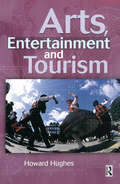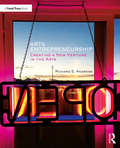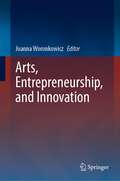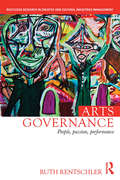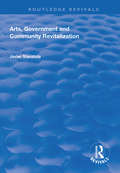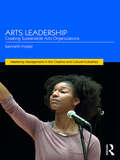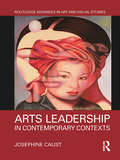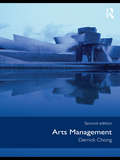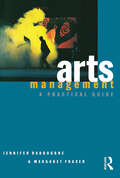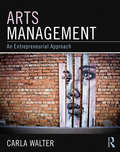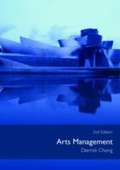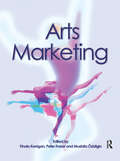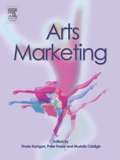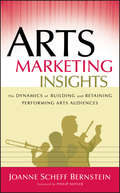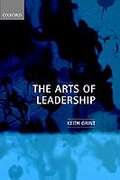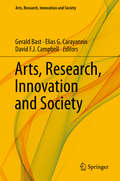- Table View
- List View
Arts, Entertainment and Tourism
by Howard Hughes'Arts, Entertainment and Tourism' is a pioneering text that, by focusing on the consumer, investigates the relationship between these 3 industries and how this relationship can be developed to its best competitive advantage. Issue-led, this text draws on appropriate disciplines rather than using one single approach, to examine issues in arts and entertainment within the framework of cultural tourism.Written to meet the needs of students studying on management courses in the arts, tourism and leisure, 'Arts, Entertainment and Tourism':* Describes the general arts and tourism background* Identifies a framework for analysis that acknowledges differing levels of interest in the arts and entertainment* Discusses the arts and entertainment that feature (past and present) in tourism * Examines the reasons why the arts, entertainment and tourism have an interest in each other and how they go about developing the relationship* Examines the relationship: are there tourists in audiences and do the arts and entertainment attract tourists to a destination?* Evaluates the wider effects (good and bad) on both the arts and tourism* Discusses the direction of future developments by arts and tourism organizations and for future research
Arts Entrepreneurship: Creating a New Venture in the Arts
by Richard AndrewsArts Entrepreneurship: Creating a New Venture in the Arts provides the essential tools, techniques, and concepts needed to invent, launch, and sustain a business in the creative sector. Building on the reader’s artistic talents and interests, the book provides a practical, action-oriented introduction to the business of art, focusing on product design, organizational planning and assessment, customer identification and marketing, fundraising, legal issues, money management, cultural policy, and career development. It also offers examples, exercises, and references that guide entrepreneurs through the key stages of concept creation, business development, and growth. Special attention is paid to topics such as cultural ventures seeking social impact, the emergence of creative placemaking, the opportunities afforded by novel corporate forms, and the role of contemporary technologies in marketing, fundraising, and operations. A hands-on guide to entrepreneurial success, this book is a valuable resource for students of Arts Entrepreneurship programs, courses, and workshops, as well as for early-stage business founders in the creative sector looking for guidance on how to create and sustain their own successful venture.
Arts Entrepreneurship: Creating a New Venture in the Arts
by Richard AndrewsArts Entrepreneurship: Creating a New Venture in the Arts provides the essential tools, techniques, and concepts needed to invent, launch, and sustain a business in the creative sector. Building on the reader’s artistic talents and interests, the book provides a practical, action-oriented introduction to the business of art, focusing on product design, organizational planning and assessment, customer identification and marketing, fundraising, legal issues, money management, cultural policy, and career development. It also offers examples, exercises, and references that guide entrepreneurs through the key stages of concept creation, business development, and growth. Special attention is paid to topics such as cultural ventures seeking social impact, the emergence of creative placemaking, the opportunities afforded by novel corporate forms, and the role of contemporary technologies in marketing, fundraising, and operations. A hands-on guide to entrepreneurial success, this book is a valuable resource for students of Arts Entrepreneurship programs, courses, and workshops, as well as for early-stage business founders in the creative sector looking for guidance on how to create and sustain their own successful venture.
Arts, Entrepreneurship, and Innovation
This book is the third publication out of the Arts, Entrepreneurship, and Innovation (AEI) Lab that focuses exclusively on research that empirically investigates crossovers between arts, entrepreneurship and innovation. This volume does so specifically by using the lens of cultural economics. The chapters in this volume have been chosen not only because they have clear implications for policy and practice, but also because they contribute to theories of value creation in the cultural and creative industries. As a whole, this book addresses relationships between arts, entrepreneurship and innovation for workers, firms, and industry to bring clarity to how value is created in the arts. Previously published in Journal of Cultural Economics Volume 45, issue 4, December 2021 Chapters “Direct Memberships in Foreign Copyright Collecting Societies as an Entrepreneurial Opportunity for Music Publishers – Needs, Challenges, Opportunities and Solutions” and “Do Museums Foster Innovation Through Engagement with the Cultural and Creative Industries?” are available open access under a Creative Commons Attribution 4.0 International License via link.springer.com.
Arts Governance: People, Passion, Performance (Routledge Research in the Creative and Cultural Industries)
by Ruth RentschlerSince the crisis in governance which led to a shortage of capable board members, recent years have seen the emergence of the enterprising arts organisation – a development which has led to the need for new types of board members who have a greater understanding of 'mission, money and merit' within a cultural construct. This innovative book explores the world of the arts board member from the unique perspective of the cultural and creative industries. Using a wide range of research techniques including interviews with board members and stakeholders, board observations and case studies this book provides a rich and deep analysis from inside the boardroom. It provides in-depth insight into the changing pressures on arts boards after the financial crisis, and focuses uniquely on the role of passion on arts boards. Part of the Routledge Research in Creative and Cultural Industries Management series, written specifically for people seeking to develop their careers in cultural and creative management, this book is also for people working in and with arts organisations, in government and non-profit arts organisations. It will also be of interest to academics and researchers working in the wider corporate governance field.
Arts Governance: People, Passion, Performance (Routledge Research in the Creative and Cultural Industries)
by Ruth RentschlerSince the crisis in governance which led to a shortage of capable board members, recent years have seen the emergence of the enterprising arts organisation – a development which has led to the need for new types of board members who have a greater understanding of 'mission, money and merit' within a cultural construct. This innovative book explores the world of the arts board member from the unique perspective of the cultural and creative industries. Using a wide range of research techniques including interviews with board members and stakeholders, board observations and case studies this book provides a rich and deep analysis from inside the boardroom. It provides in-depth insight into the changing pressures on arts boards after the financial crisis, and focuses uniquely on the role of passion on arts boards. Part of the Routledge Research in Creative and Cultural Industries Management series, written specifically for people seeking to develop their careers in cultural and creative management, this book is also for people working in and with arts organisations, in government and non-profit arts organisations. It will also be of interest to academics and researchers working in the wider corporate governance field.
Arts, Government and Community Revitalization (Routledge Revivals)
by Javier StanziolaFirst published in 1999, this book goes beyond the standard economic tools used to evaluate the effectiveness of arts in redevelopment processes. It assumes that the sectors involved in the process of arts-led community revitalization (artists, non-profit organizations, government and for-profit firms) act upon the economic structure and initiate a resurgence path. This assumption allows us to study the political and economic interaction among these sectors, understand their incentives and define and explore their boundaries. This book explores the 1) cultural and regeneration reasons for revitalization; 2) sources of funds; 3) political interaction; 4) definition and estimation of output; 5) evaluation of output; 6) estimation of coefficients and multipliers effects obtained from input-output tables.
Arts, Government and Community Revitalization (Routledge Revivals)
by Javier StanziolaFirst published in 1999, this book goes beyond the standard economic tools used to evaluate the effectiveness of arts in redevelopment processes. It assumes that the sectors involved in the process of arts-led community revitalization (artists, non-profit organizations, government and for-profit firms) act upon the economic structure and initiate a resurgence path. This assumption allows us to study the political and economic interaction among these sectors, understand their incentives and define and explore their boundaries. This book explores the 1) cultural and regeneration reasons for revitalization; 2) sources of funds; 3) political interaction; 4) definition and estimation of output; 5) evaluation of output; 6) estimation of coefficients and multipliers effects obtained from input-output tables.
Arts Leadership: Creating Sustainable Arts Organizations (Mastering Management in the Creative and Cultural Industries)
by Kenneth FosterThe contemporary world faces unprecedented upheaval and change forcing institutions of all types to rethink how they are designed and how they must now function if they are to survive into an uncertain future. The performing arts are no exception; in an era of constant change and technological transformation, arts organizations and their leaders face significant organizational challenges if they are to maintain their relevance. Arts Leadership: Creating Sustainable Arts Organizations provides a contemporary overview of the field of arts leadership, focused on the performing arts. It examines what these challenges are, how they are affecting the performing arts and arts organizations in general and proposes creative ways to reimagine, build and lead sustainable arts organizations in this uncharted environment. With a global perspective drawn from his extensive experience advising arts organizations around the world and based on his own work successfully leading important performing arts organizations in the United States, Foster proposes an innovative approach to organizational design, systems, and structures for arts leaders in the 21st century that is based in ecological thinking and the creative process that is intrinsic to the arts. In disrupting conventional arts leadership practice, the book provides an exceptional tool to understand a unique sector, and is essential reading for students and practitioners across the creative and cultural industries.
Arts Leadership: Creating Sustainable Arts Organizations (Mastering Management in the Creative and Cultural Industries)
by Kenneth FosterThe contemporary world faces unprecedented upheaval and change forcing institutions of all types to rethink how they are designed and how they must now function if they are to survive into an uncertain future. The performing arts are no exception; in an era of constant change and technological transformation, arts organizations and their leaders face significant organizational challenges if they are to maintain their relevance. Arts Leadership: Creating Sustainable Arts Organizations provides a contemporary overview of the field of arts leadership, focused on the performing arts. It examines what these challenges are, how they are affecting the performing arts and arts organizations in general and proposes creative ways to reimagine, build and lead sustainable arts organizations in this uncharted environment. With a global perspective drawn from his extensive experience advising arts organizations around the world and based on his own work successfully leading important performing arts organizations in the United States, Foster proposes an innovative approach to organizational design, systems, and structures for arts leaders in the 21st century that is based in ecological thinking and the creative process that is intrinsic to the arts. In disrupting conventional arts leadership practice, the book provides an exceptional tool to understand a unique sector, and is essential reading for students and practitioners across the creative and cultural industries.
Arts Leadership in Contemporary Contexts (Routledge Advances in Art and Visual Studies)
by Josephine CaustThis book explores and critiques different aspects of arts leadership within contemporary contexts. While this is an exploration of ways arts leadership is understood, interpreted and practiced, it is also an acknowledgement of a changing cultural and economic paradigm. Understanding the broader environment for the arts is therefore part of the leadership imperative. This book examines aspects such as individual versus collective leadership, gender, creativity and the influences of stakeholders and culture. While the book provides a theoretical and critical understanding of arts leadership, it also gives examples of arts leadership in practice.
Arts Leadership in Contemporary Contexts (Routledge Advances in Art and Visual Studies)
by Josephine CaustThis book explores and critiques different aspects of arts leadership within contemporary contexts. While this is an exploration of ways arts leadership is understood, interpreted and practiced, it is also an acknowledgement of a changing cultural and economic paradigm. Understanding the broader environment for the arts is therefore part of the leadership imperative. This book examines aspects such as individual versus collective leadership, gender, creativity and the influences of stakeholders and culture. While the book provides a theoretical and critical understanding of arts leadership, it also gives examples of arts leadership in practice.
Arts Management
by Derrick ChongThe second edition of Arts Management has been thoroughly revised to provide an updated, comprehensive overview of this fast-changing subject. Arts managers and students alike are offered a lively, sophisticated insight into the artistic, managerial and social responsibilities necessary for those working in the field. With new cases studies and several new chapters, Derrick Chong takes an interdisciplinary approach in examining some of the main impulses informing discussions on the management of arts and cultural organizations. These are highly charged debates, since arts managers are expected to reconcile managerial, economic and aesthetic objectives. Topics include: arts and the State, with reference to the instrumentalism of the arts and culture business and the arts ownership and control of arts organizations arts consumption and consumers, including audience development and arts marketing managing for excellence and artistic integrity financial investing in the arts, namely fine arts funds and theatre angels philosophies of philanthropy Incorporating a deliberately diverse range of sources, Arts Management is essential reading for students on arts management courses and provides valuable insights for managers already facing the management challenges of this field.
Arts Management
by Derrick ChongThe second edition of Arts Management has been thoroughly revised to provide an updated, comprehensive overview of this fast-changing subject. Arts managers and students alike are offered a lively, sophisticated insight into the artistic, managerial and social responsibilities necessary for those working in the field. With new cases studies and several new chapters, Derrick Chong takes an interdisciplinary approach in examining some of the main impulses informing discussions on the management of arts and cultural organizations. These are highly charged debates, since arts managers are expected to reconcile managerial, economic and aesthetic objectives. Topics include: arts and the State, with reference to the instrumentalism of the arts and culture business and the arts ownership and control of arts organizations arts consumption and consumers, including audience development and arts marketing managing for excellence and artistic integrity financial investing in the arts, namely fine arts funds and theatre angels philosophies of philanthropy Incorporating a deliberately diverse range of sources, Arts Management is essential reading for students on arts management courses and provides valuable insights for managers already facing the management challenges of this field.
Arts Management: A practical guide
by Jennifer RadbourneArts management is no longer a resting place for enthusiastic amateurs or artists with insufficient talent to make the big time. Rather, it is increasingly being recognised as a profession with a set of skills which need to be learnt.Arts Management is a comprehensive handbook for arts administrators working in all art forms and in organisations ranging from small community co-operatives to large national flagships. With extensive Australian case studies, it covers cultural policy, fundraising, legal issues, marketing and public relations, managing people and money and event management.Arts Management is an essential reference for practising arts administrators and students.
Arts Management: A practical guide
by Jennifer RadbourneArts management is no longer a resting place for enthusiastic amateurs or artists with insufficient talent to make the big time. Rather, it is increasingly being recognised as a profession with a set of skills which need to be learnt.Arts Management is a comprehensive handbook for arts administrators working in all art forms and in organisations ranging from small community co-operatives to large national flagships. With extensive Australian case studies, it covers cultural policy, fundraising, legal issues, marketing and public relations, managing people and money and event management.Arts Management is an essential reference for practising arts administrators and students.
Arts Management: An entrepreneurial approach
by Carla WalterArts Management is designed as an upper division undergraduate and graduate level text that covers the principles of arts management. It is the most comprehensive, up to date, and technologically advanced textbook on arts management on the market. While the book does include the background necessary for understanding the global arts marketplace, it assumes that cultural fine arts come to fruition through entrepreneurial processes, and that cultural fine arts organizations have to be entrepreneurial to thrive. Many cases and examples of successful arts organizations from the Unites States and abroad appear in every chapter. A singular strength of Arts Management is the author's skilful use of in-text tools to facilitate reader interest and engagement. These include learning objectives, chapter summaries, discussion questions and exercises, case studies, and numerous examples and cultural spotlights. Online instructor's materials with PowerPoints are available to adopters.
Arts Management: An entrepreneurial approach
by Carla WalterArts Management is designed as an upper division undergraduate and graduate level text that covers the principles of arts management. It is the most comprehensive, up to date, and technologically advanced textbook on arts management on the market. While the book does include the background necessary for understanding the global arts marketplace, it assumes that cultural fine arts come to fruition through entrepreneurial processes, and that cultural fine arts organizations have to be entrepreneurial to thrive. Many cases and examples of successful arts organizations from the Unites States and abroad appear in every chapter. A singular strength of Arts Management is the author's skilful use of in-text tools to facilitate reader interest and engagement. These include learning objectives, chapter summaries, discussion questions and exercises, case studies, and numerous examples and cultural spotlights. Online instructor's materials with PowerPoints are available to adopters.
Arts Management (2nd edition) (PDF)
by Derrick ChongThe second edition of Arts Management has been thoroughly revised to provide an updated, comprehensive overview of this fast-changing subject. Arts managers and students alike are offered a lively, sophisticated insight into the artistic, managerial and social responsibilities necessary for those working in the field. With new cases studies and several new chapters, Derrick Chong takes an interdisciplinary approach in examining some of the main impulses informing discussions on the management of arts and cultural organizations. These are highly charged debates, since arts managers are expected to reconcile managerial, economic and aesthetic objectives. Topics include: arts and the State, with reference to the instrumentalism of the arts and culture business and the arts ownership and control of arts organizations arts consumption and consumers, including audience development and arts marketing managing for excellence and artistic integrity financial investing in the arts, namely fine arts funds and theatre angels philosophies of philanthropy Incorporating a deliberately diverse range of sources, Arts Management is essential reading for students on arts management courses and provides valuable insights for managers already facing the management challenges of this field. The second edition of Arts Management has been thoroughly revised to provide an updated, comprehensive overview of this fast-changing subject. Arts managers and students alike are offered a lively, sophisticated insight into the artistic, managerial and social responsibilities necessary for those working in the field. With new cases studies and several new chapters, Derrick Chong takes an interdisciplinary approach in examining some of the main impulses informing discussions on the management of arts and cultural organizations. These are highly charged debates, since arts managers are expected to reconcile managerial, economic and aesthetic objectives. Topics include: arts and the State, with reference to the instrumentalism of the arts and culture business and the arts ownership and control of arts organizations arts consumption and consumers, including audience development and arts marketing managing for excellence and artistic integrity financial investing in the arts, namely fine arts funds and theatre angels philosophies of philanthropy Incorporating a deliberately diverse range of sources, Arts Management is essential reading for students on arts management courses and provides valuable insights for managers already facing the management challenges of this field.
Arts Marketing
by Finola Kerrigan Peter Fraser Mustafa OzbilginArts Marketing focuses on a variety of sectors within the arts and addresses the way in which marketing principles are applied within these, outlining both the similarities and the differences that occur. Relating policy to practice, this contributed text demonstrates the most effective means of marketing in specific areas of the arts, with each chapter having been written by a specialist in the field. Although primarily focusing on the UK market, the subject has global relevance and appeal, and policy is evaluated on national, European and supranational levels. Specialist topics dealt with range from the marketing of the theatre, opera, and museums, through to the film industry and popular music.
Arts Marketing (1st Edition) (PDF)
by Mustafa Kerrigan Finola Fraser Peter OzbilginArts Marketing focuses on a variety of sectors within the arts and addresses the way in which marketing principles are applied within these, outlining both the similarities and the differences that occur. Relating policy to practice, this contributed text demonstrates the most effective means of marketing in specific areas of the arts, with each chapter having been written by a specialist in the field. Although primarily focusing on the UK market, the subject has global relevance and appeal, and policy is evaluated on national, European and supranational levels. Specialist topics dealt with range from the marketing of the theatre, opera, and museums, through to the film industry and popular music.
Arts Marketing Insights: The Dynamics of Building and Retaining Performing Arts Audiences
by Joanne Scheff BernsteinAudience behavior began to shift dramatically in the mid 1990s. Since then, people have become more spontaneous in purchasing tickets and increasingly prefer selecting specific programs to attend rather than buying a subscription series. Arts attenders also expect more responsive customer service than ever before. Because of these and other factors, many audience development strategies that sustained nonprofit arts organizations in the past are no longer dependable and performing arts marketers face many new challenges in their efforts to build and retain their audiences. Arts organizations must learn how to be relevant to the changing lifestyles, needs, interests, and preferences of their current and potential audiences. Arts Marketing Insights offers managers, board members, professors, and students of arts management the ideas and information they need to market effectively and efficiently to customers today and into the future. In this book, Joanne Scheff Bernstein helps readers to understand performing arts audiences, conduct research, and provide excellent customer service. She demonstrates that arts organizations can benefit by expanding the meaning of "valuable customer" to include single-ticket buyers. She offers guidance on long-range marketing planning and helps readers understand how to leverage the Internet and e-mail as powerful marketing channels. Bernstein presents vivid case studies and examples that illustrate her strategic principles in action from organizations large and small in the United States, Great Britain, Australia, and other countries.
Arts Marketing Insights: The Dynamics of Building and Retaining Performing Arts Audiences
by Joanne Scheff BernsteinAudience behavior began to shift dramatically in the mid 1990s. Since then, people have become more spontaneous in purchasing tickets and increasingly prefer selecting specific programs to attend rather than buying a subscription series. Arts attenders also expect more responsive customer service than ever before. Because of these and other factors, many audience development strategies that sustained nonprofit arts organizations in the past are no longer dependable and performing arts marketers face many new challenges in their efforts to build and retain their audiences. Arts organizations must learn how to be relevant to the changing lifestyles, needs, interests, and preferences of their current and potential audiences. Arts Marketing Insights offers managers, board members, professors, and students of arts management the ideas and information they need to market effectively and efficiently to customers today and into the future. In this book, Joanne Scheff Bernstein helps readers to understand performing arts audiences, conduct research, and provide excellent customer service. She demonstrates that arts organizations can benefit by expanding the meaning of "valuable customer" to include single-ticket buyers. She offers guidance on long-range marketing planning and helps readers understand how to leverage the Internet and e-mail as powerful marketing channels. Bernstein presents vivid case studies and examples that illustrate her strategic principles in action from organizations large and small in the United States, Great Britain, Australia, and other countries.
The Arts Of Leadership
by Keith GrintLeadership is still much discussed, studied, and sought after, even though we now live in supposedly more democratic times with flatter organizations and empowered employees. But how can we best understand leadership? Are leaders born or made? Do they have particular traits or are we all potential leaders? Do the requirements for leadership change over time or are there timeless patterns? Do traditional approaches help us to pick and develop leaders or are there alternative ways that advance our understanding? In this book, Keith Grint-who has been studying and teaching leadership for over a decade-investigates the notion of leadership in a series of historical case studies and rich essay portraits of some of the most famous, and infamous, leaders (e.g. Florence Nightingale, Richard Branson, Horatio Nelson, Martin Luther King, Henry Ford, etc.). The scenarios are drawn from right across the spectrum to include business, politics, society, and the military. The first part of the book considers four sets of parallel cases where leadership appears to be a major explanation of success and failure. The second part takes the four critical issues arising from these parallel cases (identity, strategic vision, organizational tactics, and persuasive communication) and explores them in detail. One main reason we have such difficulty in explaining and enhancing leadership, Grint argues, is because we often adopt perspectives and models that obscure rather than illuminate the issues involved. The reliance upon traditional scientific analysis has not provided the anticipated advances in our understanding because leadership is more fruitfully considered as an art, or more exactly an array of arts, rather than as a science. Grint's rich and meticulously-researched profiles combine to reveal these Arts of Leadership.
Arts, Research, Innovation and Society (Arts, Research, Innovation and Society)
by Gerald Bast Elias G. Carayannis David F. J. CampbellThis book explores – at the macro, meso and micro levels and in terms of qualitative as well as quantitative studies – theories, policies and practices about the contributions of artistic research and innovations towards defining new forms of knowledge, knowledge production, as well as knowledge diffusion, absorption and use. Artistic research, artistic innovations and arts-based innovations have been major transformers, as well as disruptors, of the ways in which societies, economies, and political systems perform. Ramifications here refer to the epistemic socio-economic, socio-political and socio-technical base and aesthetic considerations on the one hand, as well as to strategies, policies, and practices on the other, including sustainable enterprise excellence, considerations in the context of knowledge economies, societies and democracies. Creativity in general, and the arts in particular, are increasingly recognized as drivers of cultural, economic, political, social, and scientific innovation and development. This book examines how one could derive and develop insights in these areas from the four vantage points of Arts, Research, Innovation and Society. Among the principal questions that are examined include:- Could and should artists be researchers?- How are the systems of the Arts and Sciences connected and/or disconnected?- What is the impact of the arts in societal development?- How are the Arts interrelated with the mechanisms of generating social, scientific and economic innovation? As the inaugural book in the Arts, Research, Innovation and Society series, this book uses a thematically wide spectrum that serves as a general frame of reference for the entire series of books to come.
